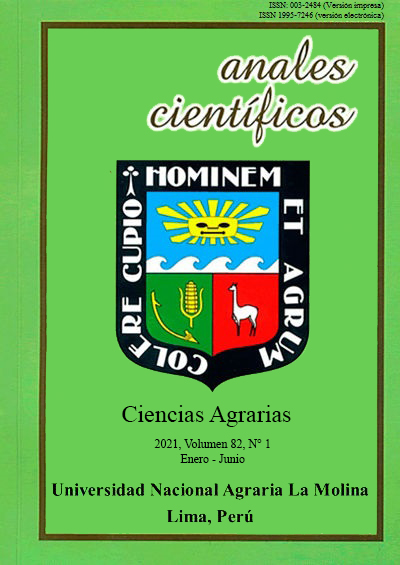Mining deforestation in Madre de Dios – Peru for years 2000 and 2017
DOI:
https://doi.org/10.21704/ac.v82i1.1748Keywords:
Gold mining, Landsat, Decision trees algorithms, Territorial categories, Peruvian AmazonAbstract
Since the 1980s gold mining in Madre de Dios, Perú has been the main deforestation driver generating severe socioeconomic and ecological impacts. The present research quantifies this activity in 2000 and 2017 by decision tree algorithms applied on a supervised classification of satellite images from LANDSAT 5 and LANDSAT 8 sensors. Results reveal an increase of 47 657,43 ha of deforestation due to gold mining between 2000 and 2017. Categorized areas showed an increase of 42,52% (35 183,45 ha), with the greatest impact on the native communities, concessions for reforestation and buffer zones of Protected Natural Areas. It is worth mentioning that there were 1 139,77 ha by 2000 that presented mining activity and were recovered by 2017. Validation by experts confirmed up to 93% of the detections with Kappa index. Decision tree methodology is direct, with quick processes and accurate results.
Downloads
References
• Arana, M., & Chang, J. (2005). Evaluación de los pasivos ambientales de la minería del río Malinowski en la reserva nacional Tambopata y su zona de amortiguamiento. Puerto Maldonado.
• Asner, G.P., Llactayo, W., Tupayachi, R., & Ráez, E. (2013). Elevated rates of gold mining in the Amazon revealed through high-resolution monitoring. Proc. Natl. Acad. Sci. 2(7), 1-6.
• Asner, G.P., & Tupayachi, R. (2017). Accelerated losses of protected forests from gold mining in the Peruvian Amazon. Environmental Research Letters, 12(9). https://doi.org/10.1088/1748-9326/aa7dab
• Brack, A. (2000). Biodiversidad amazónica y manejo de fauna silvestre. En: Manejo de fauna silvestre de la Amazonía. University of Florida UNDP/GEF, Instituto de Ecología. La Paz, Bolivia.
• Brack, A.; Ipenza, C. & Álvarez, J. (2011). Informe Sobre Minería Aurífera En Madre De Dios Y Contaminación Con Mercurio -una Bomba De Tiempo. Ministerio del Ambiente, Departamento de Investigación, Lima.
• Caballero, J., Messinger, M., RománDañobeytia, F., Ascorra, C., Fernandez, L., & Silman, M. (2018). Deforestation and Forest Degradation Due to Gold Mining in the Peruvian Amazon: A 34-Year Perspective. Remote Sensing, 10(12), 1903. https://doi.org/10.3390/rs10121903
• Castillejo, I.L., López, F., García, A., Peña, J.M., Jurado, M., Sánchez, M., & González, M. (2009). Object and pixel-based analysis for mapping crops and their agro-environmental associated measures using QuickBird imagery. Computers and Electronics in Agriculture. 68(2), 207–215. https://doi.org/10.1016/j.compag.2009.06.004
• Cerda, J., &Villarroel, P.L. (2008). Evaluación de la concordancia inter-observador en investigación pediátrica: Coeficiente de Kappa. Pontificia Universidad Católica de Chile.
• De Echave, J. (2016). La minería ilegal en Perú. Nueva Sociedad, 263(2), 131–144. Recuperado de https://www.minjus.gob.pe/wpcontent/uploads/2018/03/07_Mineria-ilegalArticulo-Peru-06.pdf
• Díaz, Z., Fernández, J., & Segovia, M. (2005). El Algoritmo See5 versus la metodología Rough Set. Una aplicación a la predicción de la insolvencia en empresas españolas de seguros no-vida. Cuadernos de Estudios Empresariales (15), 179-198. Norteamérica. URL:https://revistas.ucm.es/index.php/CESE/article/view/CESE0505110179A
• Dourojeanni, M. (2006). Estudio de caso sobre la carretera interoceánica en la Amazonía sur del Perú. http://siar.minam.gob.pe/puno/sites/default/files/archivos/public/docs/437.pdf
• Escobar-Pérez, J., & Cuervo-Martínez, Á. (2008). Validación de contenido y juicio de expertos: Una aproximación a su utilización. Avances en Medición, 6, 27–36. Colombia.
• Finer, M., Olexy, T., & Novoa, S. (2016). Gold Mining Deforests 32000 Acres in southern Peruvian Amazon from 2013 to 2016. MAAP, 50. https://maaproject.org/2016/peru_gold
• Gutiérrez, J., & Jegat, H. (2005). Uso de la teoría de lógica difusa en la clasificación de imágenes satelitales con coberturas mixtas: el caso urbano de Mérida, Venezuela. Interciencia, 30(5), 261-266.
• INEI. [Instituto Nacional de Estadística e Informática]. (2016). Capa temática de los límites políticos del Perú. Consultado el 09 de octubre del 2017. Disponible en: https://www1.inei.gob.pe/contactenos/
• INEI. [Instituto Nacional de Estadística e Informática]. (2017). Censos Nacionales 2017: XII de Población, VII de Vivienda y III de Comunidades Indígenas. Consultado el 14 de abril del 2021.
• Landis, J., & Koch, G. (1977). The measurement of observer agreement for categorical data. University of Michigan. Biometrics, 33(1), 159-174. https://doi.org/10.2307/2529310.
• Medina, G., Arévalo, A.J., & Quea, J.F. (2007). Estudio de Investigación de la Minería Ilegal en el Perú, Repercusiones para el sector minero y el país. Encuentro Empresarial: XXVIII Convención Minera.
• Moran, E.F., & Brondizio, E. (1994). Integrating of Amazonian vegetation, land use, and satellite data. Bioscience, 44, 329-338.
• OSINFOR. (2016). Contribución en el monitoreo de la actividad minera en títulos habilitantes forestales, año 2014 - Departamento de Madre de Dios. Recuperado de https://www.osinfor.gob.pe/wpcontent/uploads/2016/06/Mineria-Madre-deDios-21-de-junio.pdf
• Osores, F., Rojas, J.E., & Manrique, C.H. (2012). Minería informal e ilegal y contaminación con mercurio en Madre de Dios: Un problema de salud pública. Acta Médica Peruana. 29(1), 38-42. Accesado http://www.scielo.org.pe/scielo.php?script=sci_arttext&pid=S1728-59172012000100012&lng=es&tlng=es.
• OTCA. [Organización del Tratado de Cooperación Amazónica]. (2016). Monitoreo de la Cobertura Forestal en la Región Amazónica. Fundo Amazonia, 3(3), 1-8. Brasil. URL:http://www.fundoamazonia.gov.br/export/sites/default/pt/.galleries/documentos/acervoprojetos-cartilhas-utros/OTCA-Boletin-3-Proyecto-Monitoreo.pdf
• Quintanilla, T., & Maguiña, K. (2008). Evaluación preliminar del impacto social de la minería aurífera aluvial en las zonas de Huepetuhe, Pukiri y Cabecera de Malinowsky, de la región Madre de Dios. Pro-Naturaleza y Movimiento El Pozo.
• Rodrigues, A.S., Andelman, S.J., Bakarr, M.I., Boitani, L., Brooks, T.M., Cowling, R.M., & Yan, X. (2004). Effectiveness of the global protected area network in representing species diversity. Nature 428,640–643. https://doi.org/10.1038/nature02422.
• SERFOR. [Servicio Nacional Forestal y de Fauna Silvestre]. (2017). Capa temática de las categorías territoriales del Perú. Consultado el 09 de octubre del 2017. Disponible en: http://geo.serfor.gob.pe/geoserfor/
• Swenson, J.J., Carter, C.E., Domec, J.C., & Delgado, C.I. (2011). Gold mining in the Peruvian Amazon: global prices, deforestation, and mercury imports. PLoS One. 6(4): e18875.
• USGS. [United States Geological Survey]. (2018). Band designations for the Landsat satellites. Disponible en https://www.usgs.gov/faqs/what-are-banddesignations-landsat-satellites?qtnews_science_products=0#qtnews_science_products
• Vuletič, S., Kern, J., Sonicki, Z., & Ivankovič, D. (1999. Possibilities of see5 software in forecasting of life expectancy not achieving. In Serie: “Studies in Health Technology and Informatics”. 68: 696-699. https://doi.org/10.3233/978-1-60750-912-7-696.
Downloads
Published
Issue
Section
License
Copyright (c) 2021 Lasmit Cerón C., Natalia Miranda S., Ethel Rubin-de-Celis L.

This work is licensed under a Creative Commons Attribution-ShareAlike 4.0 International License.










